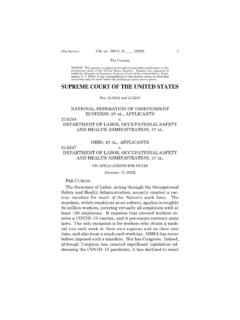Transcription of The National Programme for IT in the NHS
1 The National Programme for IT in the NHS A Case History Oliver Campion-Awwad, Alexander Hayton, Leila Smith and Mark Vuaran February 2014 MPhil Public Policy 2014, University of Cambridge 2 Contents Introduction .. 3 Aim of this case history .. 3 Structure .. 3 Early years of the electronic patient record .. 5 Background: genealogy of a National Programme .. 5 Information for Health : good practice gone bad .. 8 Opposition: confidentiality and the electronic patient record .. 10 NPfIT: doomed to failure? .. 11 NPfIT: Launch, Delivery and Implementation .. 15 The launch of NPfIT.
2 15 Recommendations from the Wanless Review .. 16 Issues in the Gate Zero Review .. 16 The draft OBS and NSP Plan Timetable .. 17 Director General s appointment and approach to contracting .. 18 The revised OBS .. 19 Procurement process .. 19 Procurement concerns .. 21 Leadership changes and Connecting for Health .. 22 iSoft and Accenture .. 23 Delivery and Implementation .. 24 Electronic Care Record Delays .. 24 System Functionality .. 27 Changes in suppliers .. 28 Privacy Concerns .. 28 The End of NPfIT .. 30 Delivery .. 32 CSC .. 32 Value for Money .. 33 Conclusion.
3 36 Would it happen again today? .. 36 Appendix 1 .. 40 Bibliography .. 41 3 Introduction The National Programme for IT in the NHS (NPfIT) was the largest public sector IT Programme ever attempted in the UK, originally budgeted to cost approximately 6 billion over the lifetime of the major contracts. After a history marked by delays, stakeholder opposition and implementation issues, the Programme was dismantled by the conservative - liberal Democrat Government in 2011, almost ten years after Prime Minister Tony Blair initiated it at a seminar in Downing Street in 2002. The core aim of NPfIT was to bring the NHS use of information technology into the twenty-first century, through the introduction of integrated electronic patient records systems, online choose and book services, computerised referral and prescription systems and underpinning network infrastructure.
4 Despite the failure of many of these services to be delivered, the government, and ultimately taxpayers, incurred significant costs for the Programme , including contract transition and exit costs which continue to accrue in 2013/2014. Aim of this case history This case history of NPfIT investigates what went wrong with the Programme , identifying three main themes: Haste. In their rush to reap the rewards of the Programme , politicians and Programme managers rushed headlong into policy-making, procurement and implementation processes that allowed little time for consultation with key stakeholders and failed to deal with confidentiality concerns; Design.
5 In an effort to reduce costs and ensure swift uptake at the local levels, the government pursued an overambitious and unwieldy centralised model, without giving consideration to how this would impact user satisfaction and confidentiality issues; and Culture and skills. NPfIT lacked clear direction, project management and an exit strategy, meaning that the inevitable setbacks of pursuing such an ambitious Programme quickly turned into system-wide failures. Furthermore, the culture within the Department of Health and government in general was not conducive to swift identification and rectification of strategic or technical errors.
6 Structure The first part presents the history of electronic patient records and healthcare information systems in general, identifying several key trends that, had the government learned from them, could have prevented further issues with the implementation of NPfIT. It also looks at the issue of confidentiality and the decision making process behind NPfIT and asks the question Was NPfIT doomed to failure? 4 The second part details the procurement processes and failures in the early years of NPfIT. It highlights several issues that should have acted as warning signs for the government of the time.
7 It details the implementation issues that became apparent during the later years of NPfIT and demonstrates how, despite the history of previous IT failures, the government failed to learn the lessons of the past. The final part outlines the history of NPfIT before and after the 2010 general election, after which the decision was made to dismantle the ailing Programme . Our conclusion brings together the themes addressed throughout the paper and identifies underlying questions about why major public sector IT projects go wrong and whether NPfIT style failures are likely to be repeated. 5 Early years of the electronic patient record Electronic patient record (EPR) systems were introduced at a time when healthcare professionals would use a pen or pencil to make notes on a patient s GP referral letter as part of the old paper-based patient care record (MPA, 2011).
8 NHS Executive (1998, ) states that Individualised personal electronic records [..] provide NHS professionals with 24 hour secure access to the information important to individual patients care, when required. This will immeasurably improve emergency care and ensure any professional involved in the care of an individual is up to date with their treatment. There are four main groups of beneficiaries of such systems (NHS Executive, 1998): 1. Patients, who can use EPR systems to see their own test results from home and to understand NHS performance data; 2. Healthcare professionals, who can use EPR systems to gain access to fast, reliable and accurate information about patients, local and National knowledge bases and information to support them in their work; 3.
9 NHS managers and planners, who can use secondary data from EPR systems to gain access to high-quality information that helps them target and utilise resources; and 4. The public, who can use secondary data from EPR systems to assess the performance of local hospitals and other healthcare service providers. As well as these immediate benefits, EPR systems can help prevent blunders (interview with Brennan, 2014) and have been shown to be more understandable and legible than paper-based records, as well as being more likely to contain at least one diagnosis and more detailed referrals (Hippesley-Cox et al.)
10 , 2003). Furthermore, EPR systems can vastly improve the accumulation and dissemination of information on public health (Laporte, 1994, ), and can be used to inform public health policy by mapping, for example, a disease s resistance to antibiotics (STC, 1998). Some, notably L rum et al. (2001) have questioned these advantages. Nonetheless, there is a wide acceptance of the need for EPR systems, with even those who express reservations about some aspects of the EPR (for example, Tonks) accepting that its medical benefits are undeniable (1993, ). Background: genealogy of a National Programme The National Programme for IT in the NHS (NPfIT) was the most costly IT project in the history of the NHS, but was by no means the first (Brennan, 2005.
















